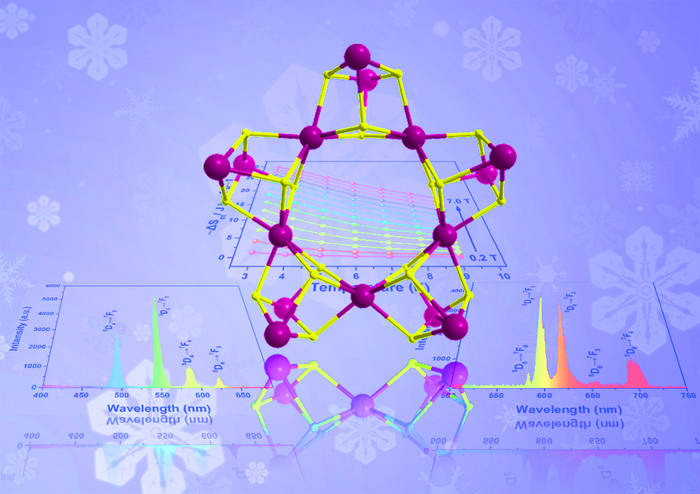While the wheel does not need to be reinvented, there are benefits to the development of new nano-wheels, according to a multi-institute research team based in China. The group fabricated a novel family of metallic compounds, each of which exhibit unique properties desirable for next-generation technologies, such as advanced sensors.

Credit: Polyoxometalates, Tsinghua University Press
While the wheel does not need to be reinvented, there are benefits to the development of new nano-wheels, according to a multi-institute research team based in China. The group fabricated a novel family of metallic compounds, each of which exhibit unique properties desirable for next-generation technologies, such as advanced sensors.
Their findings were made available online on March 12 in Polyoxometalates.
“Polymetallic complexes are of great interest not only for their appealing molecular structure but also for their versatile applications in various fields,” said co-corresponding author Yan-Zhen Zheng, professor in the Frontier Institute of Science and Technology (FIST) at Xi’an Jiaotong University.
Polymetallic complexes, which comprise multiple atoms of various metals or a combination of metals and other elements, have the potential to imbue materials with specific properties if the molecules can be synthesized, Zheng said. Such properties include the ability to fluoresce, or glow, and magnetic quirks that allow drastic temperature changes and control.
Zheng and his team focused on creating polymetallic complexes made with lanthanide elements, a group of 15 metallic materials also known as rare earth elements. They specifically used europium, terbium and gadolinium.
“Among all polymetallic complexes, lanthanide-based compounds have drawn unprecedented attention due to their interesting magnetic and luminescence behaviors,” Zheng said. “Several such compounds have been successfully isolated, but direct synthesis has been a challenge.”
The components of the complexes require are geometrically diverse, requiring significant coordination, according to Zheng.
“Previous findings revealed that controlling the hydrolysis — breaking down a compound with water — of lanthanide metal ions in the presence of appropriate organic ligands would be a powerful strategy to obtain desired species,” Zheng said. A ligand is a molecule that bonds to a metal atom. Its addition to the complex can stabilize the structure.
The researchers used hydrolysis to breakdown lanthanides in a bath containing a ligand called tricine. Tricine contains multiple arms of oxygen and hydrogen, meaning it can accommodate a large range of metals and help stabilize the resulting clusters.
“Through the simple hydrolysis reaction, we synthesized three lanthanide nano-clusters, and used X-ray diffraction analyses to reveal their stable, wheel-like structure,” Zheng said. “Owing to the presence of different lanthanide metal ions in these analogues, each compound shows distinctive properties.”
The europium-based cluster fluoresced red emissions, while the terbium-based cluster fluoresced green emissions. The gadolinium-based cluster exhibited potential applications in magnetic cooling. According to Zheng, the research group is continuing to investigate the synthesis and application of these clusters.
Other contributors include Peng-Fei Sun, Xiao-Nan Zhang, Cai-Hong Fan and co-corresponding author Wei-Peng Chen, all with FIST, the State Key Laboratory of Mechanical Behavior for Materials, the MOE Key Laboratory for Nonequilibrium Synthesis of Condensed Matter, the Xi’an Key Laboratory of Sustainable Energy and Materials Chemistry and the School of Chemistry at Xi’an Jiaotong University
The National Science Foundation of China, the Special Support Plan of Shaanxi Province for Young Top-Notch Talent, the Instrument Analysis Center of Xi’an Jiaotong University and the Fundamental Research Fund for Central Universities supported this work.
##
About Polyoxometalates
Polyoxometalates is a peer-reviewed, international and interdisciplinary research journal that focuses on all aspects of polyoxometalates, featured in rapid review and fast publishing, sponsored by Tsinghua University and published by Tsinghua University Press. Submissions are solicited in all topical areas, ranging from basic aspects of the science of polyoxometalates to practical applications of such materials. Polyoxometalates offers readers an attractive mix of authoritative and comprehensive Reviews, original cutting-edge research in Communication and Full Paper formats, Comments, and Highlight.
About SciOpen
SciOpen is a professional open access resource for discovery of scientific and technical content published by the Tsinghua University Press and its publishing partners, providing the scholarly publishing community with innovative technology and market-leading capabilities. SciOpen provides end-to-end services across manuscript submission, peer review, content hosting, analytics, and identity management and expert advice to ensure each journal’s development by offering a range of options across all functions as Journal Layout, Production Services, Editorial Services, Marketing and Promotions, Online Functionality, etc. By digitalizing the publishing process, SciOpen widens the reach, deepens the impact, and accelerates the exchange of ideas.
Journal
Polyoxometalates
DOI
10.26599/POM.2023.9140026
Article Title
Tricine Supported Polyoxo(alkoxo)lanthanide Cluster {Ln15} (Ln = Eu, Gd, Tb) with Magnetic Refrigerant and Fluorescent Properties
Article Publication Date
12-Mar-2023




